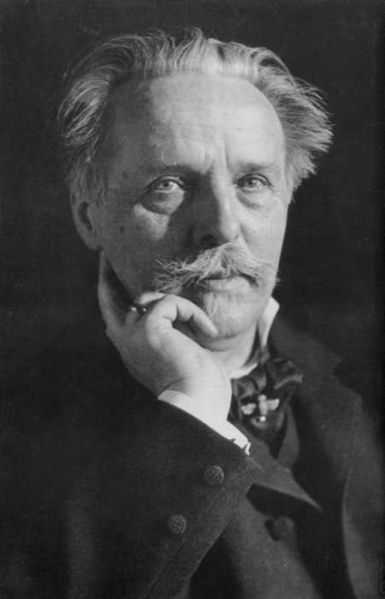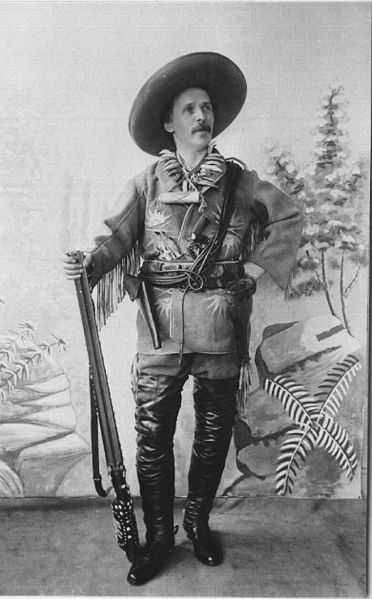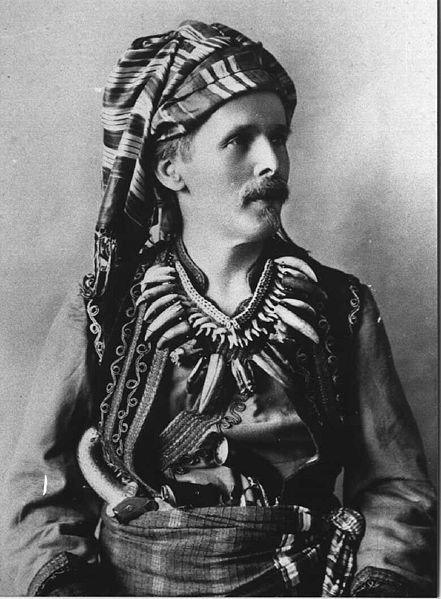<Back to Index>
- Philosopher Benedetto Croce, 1866
- Writer Karl Friedrich May, 1842
- Emperor of China Xuande, 1398
PAGE SPONSOR



Karl Friedrich May (February 25, 1842 – March 30, 1912) was a German writer, noted mainly for books set in the American Old West, (best known for the characters of Winnetou and Old Shatterhand) and similar books set in the Orient and Middle East (with Kara Ben Nemsi and Hadschi Halef Omar). In addition, he wrote stories set in his native Germany, in China and in South America. May also wrote poetry and a play, as well as composing music; he was proficient with several musical instruments. May's musical version of Ave Maria became very well known. Many of his works were filmed, adapted for the stage, processed to audio dramas or transcribed into comics.
Karl May was born into a family of poor weavers in Ernstthal, Schönburgische Rezessherrschaften (later part of the Kingdom of Saxony). He was the fifth child out of fourteen, nine of them died within several months. According to his autobiography, he suffered from visual impairment shortly after birth and regained his eyesight after treatment at the age of five. Possibly a lack of vitamin A led to night blindness, which got worse. During his school time he got private music and composition lessons. In 1856 he started his teacher training in Waldenburg, but was excluded in 1859, because he embezzled six candles. After a petition he was allowed to continue his education in Plauen. His career as a teacher ended in 1861 abruptly after few weeks when he was accused by his roommate of stealing a pocket watch. Therefore he had to be in gaol in Chemnitz for six weeks and his license to teach was revoked permanently.
During the following years he tried to earn a living by giving private lessons, writing tales, composing and declaiming. But these did not secure his livelihood. As a consequence he engaged in thefts and frauds. He was sentenced to four years in a workhouse. From 1865 to 1869 he was in gaol in the Osterstein Castle (Zwickau). Because of good behaviour he became administrator of the prison’s library and had the chance to read much including travel literature. He planned to become an author and made a list of titles named Repertorium C. May. After his release he relapsed and engaged again in thefts and frauds. Compared to the effort the loot was meagre. He got caught, but during the judicial investigation, when he was transported to the crime scenes, he escaped. May fled beyond Saxon boundaries to Bohemia, where he was detained for vagabondage. He was in gaol again in Waldheim from 1870 to 1874. There he met the catholic prison’s catechist Johannes Kochta, who’s influence helped May to turn around.
After May’s release in May 1874 he went back to his parents in Ernstthal and started writing. His first known published tale (Die Rose von Ernstthal) was in November 1874. It was a time when the German press was on the move. Industrialisation, increasing literacy and economic freedom led to many startup presses (especially in the field of light fiction). Already in the time between his two long imprisonments he developed contacts with the publisher Heinrich Gotthold Münchmeyer in Dresden. Now he engaged May as editor in his press. For the first time his livelihood was secure. He directed several entertainment papers (e.g. Schacht und Hütte) and wrote and edited numerous articles (e.g. Geographische Predigten, 1875/76). May quit in 1876, because his employer tried to bond him on his company by marriage with Münchmeyer’s sister-in-law and the firm had a bad reputation. After a second engagement as editor in the press of Bruno Radelli, Dresden, in 1878 he became a freelance writer and moved to Dresden together with his girlfriend Emma Pollmer, whom he married 1880. But his publications did not result in a regular income yet; there were rent and other arrears.
In 1879 Deutscher Hausschatz, a catholic weekly journal from the press of Friedrich Pustet in Regensburg, published the tale Three carde monte. After some more stories, they made an offer to May for several more of his tales: In 1880 he started the Orient Cycle,
which ran with interruptions until 1888. But at the same time he also
wrote for other journals, used pseudonyms and different titles to get
multiple payments for his texts. Until his death more than one hundred
tales were published in instalments in diverse journals. Another
important journal was Der Gute Kamerad of Wilhelm Spemann, Stuttgart, later on Union Deutsche Verlagsgesellschaft, which was a magazine for boys in secondary school. There his first tale was published in 1887 (Der Sohn des Bärenjägers) and it printed one of his most famous stories: Der Schatz im Silbersee (1890/91). In 1882 there was new contact with H. G. Münchmeyer and May started the first of five very large colportage novels for his former employer. Das Waldröschen (1882 – 1884)
was many hundred thousandfold reprinted until 1907. But May made just a
verbal agreement with his friend Münchmeyer and later on this
became a problem. In October 1888 May moved to Kötzschenbroda (a part of Radebeul) and 1891 into Villa Agnes in Oberlößnitz (another part of Radebeul). The key breakthrough came in 1891 by contact with Friedrich Ernst Fehsenfeld, who offered to print the Deutsche Hausschatz stories as books. With the start of the new book series Carl May’s Gesammelte Reiseromanein 1892 (since 1896 Karl May's Gesammelte Reiseerzählungen)
for the first time May experienced financial security and glory. But
after a short time he had problems differentiating between reality and
fiction and went as far as to say he had experienced himself as Old Shatterhand, resp. Kara Ben Nemsi. This was the so called "Old-Shatterhand-Legend". A gunsmith in
Kötzschenbroda manufactured the legendary guns of the heroes in
his novels for him, first the "Bärentöter" (Bear Killer) and
the „Silberbüchse“ (The Silver Gun), later on the "Henrystutzen" (Henry rifle). The readers followed the equalisation of author and protagonist and
sent numerous letters to him. In the following years he took talk tours
in Germany and Austria, printed autograph cards and allowed costume
photos. In December 1895 he moved into the Villa "Shatterhand" in Alt-Radebeul, which he bought from the Ziller Brothers. In 1899/1900
May travelled to the Orient. In the first part he was for nearly
three-quarters of a year alone just accompanied by his servant Sejd Hassan
and went from Egypt to Sumatra. In 1900 he met his wife and his friends, the couple Klara and Richard Plöhn.
Together they continued the journey and got back to Radebeul in July
1900. During the year and a half May wrote a travel diary, which is
extant in fragments and transcription parts. According to his second
wife Klara (widowed Plöhn, see below) May had two times a nervous
breakdown during the journey, which lasted both times over a week. Hans Wollschläger and Ekkehard Bartsch believe that this was due to an irruption of the reality into May’s dream world. He overcame the crisis without medical benefit. While May was on his Orient journey, attacks in the press set in, especially pursued by Hermann Cardauns and Rudolf Lebius.
They criticised – with different motivations – May’s self promotion and
the associated Old-Shatterhand-Legend. Simultaneously they reproached his religious sham (he wrote as protestant for the catholic Deutscher Hausschatz and several Marian calendars), immorality and later on his criminal history. These polemics and
several trials about unauthorized book publications lasted until his
death. His broken matrimony was dissolved in 1903 by May’s endeavour.
According to May, Emma, who was a friend of adversary Pauline Münchmeyer (widow of H.G. Münchmeyer), embezzled
documents, which could have verified the verbal agreement with
Münchmeyer. In the same year he married the widow Klara Plöhn. Since his first employment as editor May added illegally a doctoral degree to his name. 1902 he got an Doctor honoris causa by the Universitas Germana-Americana in Chicago for his work Im Reiche des Silbernen Löwen. Christian Heermann assumes, this happened on endeavour of May or Klara Plöhn to give the false doctoral degree a legal basis. This university was a known diploma mill, where degrees could be bought for money.
In 1908 Karl and Klara May travelled for six weeks to North America. They visited among others Albany, Buffalo, the Niagara Falls and some friends in Lawrence. But he did not reach the Wild West. May used the journey as inspiration for his book Winnetou IV.
Since
his Orient journey May wrote in a different way. He called his former
works "preparation" and started then writing complex, allegoric texts. He was convinced to solve or at least to discuss the "question of mankind". He turned deliberately to pacifism and wrote several books about the raising of humans from "evil" to "good". The friendship to the artist Sascha Schneider led to new symbolistic covers for the Fehsenfeld edition. An exultant approval May experienced on March 22, 1912; he was invited by the Academic Society for Literature and Music in Vienna to hold the talk Empor ins Reich der Edelmenschen ("Upward to the realm of noble men"). Thereby he met his friend the Nobel Peace Prize laureate Bertha von Suttner. Karl May died one week later on March 30, 1912. According to the register of deaths, the cause was "cardiac arrest, acute bronchitis, asthma". Today an (unrecognised) lung cancer is not excluded. May was buried on the graveyard Radebeul-East. The tomb was inspired by the Temple of Athena Nike Klara had seen on the Orient travel.